Dolgarrog is a village situated in the ancient county of Caernarfonshire, situated in the valley of the River Conwy, to the west of the main A470 road between Llanrwst and Conwy. The village grew as a result of its aluminium works, which drew people to move to the area for work. The men of the village who fell during both World Wars are commemorated on the Dolgarrog war memorial, which is situated in the Gardens of the British Legion Club at Conway Road. The memorial was unveiled in 1927 to commemorate the fallen of the First World War, then had additional names added to commemorate those who fell during the Second World War.
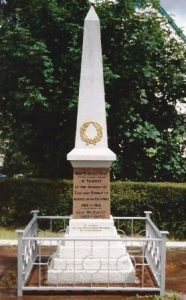
The Great War, 1914-1918
Charles Angelo Carpenter, Gunner, 108687, Royal Field Artillery. Charles was born in 1876, the son of Angelo Carpenter and Marie Louise Carpenter (nee Roy), of Back’s House, Binstead, Hants. He came to North Wales to find work as a lead miner as a young man and in 1898 married Louisa Pritchard, of Llanrwst. The couple initially resided at 4, Miner’s Bridge, Betws-y-Coed, before moving to 7, Hillside Road, Dolgarrog and gained work as a coachman. Charles enlisted at Liverpool into the Royal Field Artillery soon after the outbreak of war and was posted to the 22nd Brigade, Royal Field Artillery, embarking for France on 6 October 1914. The Battery was attached to the 7th Division and landed at Zeebrugge on 8 October, however the City was in the process of falling to the Germans, and the Division moved to Ypres, where it became the first British Division to hold the city. The division fought during the First Battle of Ypres, and helped stop the German advance through Belgium, then in March 1915 fought at the Battle of Neuve Chapelle. During May the division fought at the Battle of Aubers Ridge, and then at the Battle of Festubert, before taking part in the Battle of Loos in September. Charles was later transferred to A Battery, 79th Brigade, Royal Field Artillery, which was attached to the 17th (Northern) Division. The division had moved to France in July 1915 and spent its initial period of trench familiarisation in the southern area of the Ypres salient, where it took part in the heavy fighting at the Bluff during February 1916. The division then moved south to take part in the Somme offensive, wintering on the Somme before transferring to the Arras sector in February 1917. The division then took part in the Arras offensive, which opened on 9 April 1917, with the divisional artillery, initially firing from positions on the edge of Arras, moving forward to positions at Monchy-le-Preux by 15 April. Charles was one of three men of the battery killed whilst registering their guns upon the German trenches on 24 April 1917. The body of the 41-year-old was brought back to Arras, and he was buried in Faubourg D’Amiens Cemetery, Arras, France.
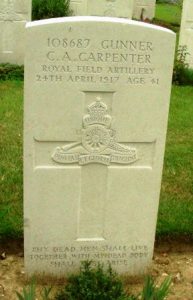
Harry Claude Jack, Second Lieutenant, Royal Flying Corps. Harry was born at Cardiff on 4 November 1892, the son of Henry Joseph Jack and Emily Jack (nee Burn). His parents were both from Swansea, but his father became a renowned businessman, so the family moved to follow his work and by the turn of the century had settled at Maenan Manor, Llanrwst, after Harry’s father had become manager of the Dolgarrog Aluminium Works. Harry trained in civil engineering at Brussels and then in London. Harry had been commissioned as Second Lieutenant into the Royal Engineers on 12 June 1911, and served with the 4th London Field Company, 2nd London Divisional Engineers, Royal Engineers, which was a Territorial Army unit. He married Vera Gertrude Mumford on 2 September 1912, then on 23 September 1913 the couple left England for Canada, where Harry had gained a position as a civil engineer for the North American railroads. Harry returned to England three months after the outbreak of war and was commissioned as Second Lieutenant into the Highland Light Infantry in December. Harry did not serve overseas, but volunteered to transfer to the Royal Flying Corps, where he trained as a pilot. He was then posted to 41 Squadron, RFC, which was stationed at Fort Rowner, in Gosport, Hampshire, to continue his training. On 1 September 1916 Harry took off from Fort Rowner, flying a Henry Farman HF.20, Serial 7445. As he was climbing, the aircraft stalled and dived into the ground, bursting into flames, and killing Harry. The remains of the 23-year-old were recovered from the wreckage, and he was buried in Ann’s Hill Cemetery, Gosport.
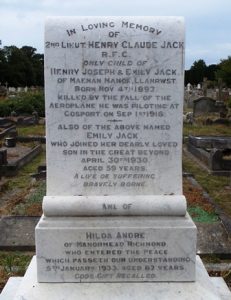
John Thomas Jones, Private, 8252, Royal Welsh Fusiliers. John was born in about 1885, the son of John Lloyd Jones and Jane Jones (nee Williams), of Mount Pleasant, Abergele. John had enlisted at Abergele into the Royal Welsh Fusiliers as a young man but had left the army by the time he married Caroline Roberts in 1907 and the couple set up home at Llewelyn Street, Penmachno, where their three children were born. The couple had moved to 11, Hillside, Dolgarrog prior to the war. As a former soldier, John was an Army Reservist, and was mobilised at the outbreak of war. He embarked for France with the 2nd Battalion, Royal Welsh Fusiliers on 13 August 1914. The battalion was initially placed on Lines of Communication at Rouen, before joining 19 Brigade at Valenciennes, taking part in the retreat to the Marne with the BEF. Following the Battles of the Marne and the Aisne, 19 Brigade moved to Flanders with the BEF, and eventually took over the La Boutillerie sector by 22 October, after becoming attached to the 6th Division. The battalion took up positions around La Cordonnerie Farm that day, with B Company in reserve and a French cavalry unit on their right flank. Over the coming days, the battalion beat off a number of enemy attacks upon its positions, suffering a constant drain of casualties each time, as well as casualties suffered by sniping. John was wounded during this trying period, and was evacuated to the Clearing Hospital at Bailleul, where he died of his wounds on 31 October 1914. The 29-year-old was buried in Bailleul Communal Cemetery Extension, France.
A Lloyd, Fusilier. This man cannot presently be identified.
Owen Lloyd, Private, 3089, Royal Welsh Fusiliers. Owen was born on 14 November 1895, the illegitimate son of Annie Lloyd, of 3, Singrig, Dolwyddelan. He was raised by his grandmother Mary, then after his mother married Ellis Roberts in 1906, Owen went to live with her at Aber Beinw, Dolwyddelan. Owen worked as a farm labourer at Plas Arfon prior to enlisting at Llanrwst into the 5th Battalion, Royal Welsh Fusiliers soon after the outbreak of war. The battalion was a Territorial Army unit which mobilised at Flint as part of North Wales Brigade, Welsh Division and moved to Conway until the end of the month, before moving to Northampton. In December the Division moved to Cambridge and then in May 1915 to Bedford, where the Division was numbered and the formation became 158 Brigade, 53rd (Welsh) Division. On 19 July 1915 the entire Division sailed from Devonport for Imbros and on 9 August 1915 landed at Suvla Bay. The infantry moved off the beaches across the Salt Lake, under shellfire, into the scrub covered Chocolate Hill, but due to a lack of maps and no knowledge of the terrain, many of the units became disorientated, and the situation became chaotic. Owen survived the worst of the fighting over the next few days, and the entire Gallipoli front then settled back down into a stalemate. On 22 September 1915 the 5th RWF were at work at West Beach, constructing dugouts, when Owen was killed by a Turkish shell. The 19-year-old was buried in Hill 10 Cemetery, Gallipoli.
John MacDonald, Private, 18683, Royal Welsh Fusiliers. John was born at Rosskeen, in Scotland and was married to Janet MacDonald (nee English). The couple had moved around the country before settling at Dolgarrog in the years prior to the war. John enlisted into one of the newly formed Service Battalions of the Royal Welsh Fusiliers for the 38th (Welsh) Division at Conwy soon after the outbreak of war. He did not embark for France with the division in December 1915, but initially remained at Kinmel Park before being drafted to Egypt at some time in 1916 to join the 8th Battalion, Royal Welsh Fusiliers. The battalion had formed at Wrexham in August, joining 40 Brigade, 13th (Western) Division on Salisbury Plain, and had seen service at Gallipoli before being evacuated to Egypt on 8 January 1916, concentrating at Port Said, where it held forward posts in the Suez Canal defences. On 12 February 1916 the Division began to move to Mesopotamia, to strengthen the force being assembled for the relief of the besieged garrison at Kut al Amara. By 27 March, the Division had assembled near Sheikh Saad and came under orders of the Tigris Corps, and then took part in the attempts to relieve Kut. However, after these efforts failed and Kut fell, the British force in the theatre was built up and reorganised. The Division then fought at the Battle of Kut al Amara, then at the capture of the Hai Salient and the capture of Dahra Bend. The division then took part in the passage of the Diyala, in the pursuit of the enemy towards Baghdad. John was killed whilst the 8th RWF was holding an advanced picquet on 3 February 1917. He has no known grave and is commemorated on the Basra Memorial, Iraq. His widow and three children later moved back to Scotland.
Joseph William Pettifor, Sergeant, 15481, Royal Welsh Fusiliers. Joseph was born at Chesterfield on 20 May 1893, the son of John Robert Pettifor and Ellen Pettifor (nee Green). His father worked as a steam crane driver for a railway construction company, and the family moved around the country over the years, spending several years in Fishguard, before moving to Coeti Huts, Talybont by 1911. Joseph worked as a labourer prior to enlisting into the 10th Battalion, Royal Welsh Fusiliers at Conwy soon after the outbreak of war. The battalion had formed at Wrexham in September 1914, joining 76 Brigade, 25th Division at Codford St. Mary, Salisbury Plain. In November 1914 the battalion moved to billets at Bournemouth, then at the end of April 1915 moved to Romsey before moving again to Aldershot to complete its training. The battalion landed at Boulogne on 27 September 1915 and the entire division moved to the Ypres Salient for trench initiation, before taking over the line at St. Eloi, near Ypres. On 15 October, 76 Brigade transferred to the 3rd Division. The Division saw heavy fighting during the Actions of the Bluff in February 1916 and then at the Actions of the St Eloi Craters from 27 March to 16 April. The battalion continued to suffer during these months at St. Eloi, coming under a gas attack for the first time on 29/30 April. By the middle of June, the Division had moved out of the Ypres Salient to billets around Eperlecques, where intense training was carried out prior to moving to the Somme sector by 2 July. The main Somme offensive had opened on the previous day, and the 3rd Division was ready to enter the fray, bivouacking at Bronfay Farm by 9 July and on 13 July moved into the captured German lines at Montauban Alley. The 10th RWF took part in heavy fighting over the coming days, and on 19 July received orders for an assault on Delville Wood. Just after midnight the following day the battalion moved forwards and became caught in in terrible fighting within the wood, the fighting of such severity that two men of the battalion were awarded the Victoria Cross. Joseph was wounded during this terrible fighting on the Somme and was evacuated back to Britain. Upon recovering, he was drafted out to Salonika to join the 11th Battalion, Royal Welsh Fusiliers, which was attached to 67 Brigade, 22nd Division. Joseph was killed in action during a trench raid carried out by the 11th RWF on 6 May 1918, which was sent out to blow up a concrete enemy machine-gun post. The 25-year-old has no known grave and is commemorated on the Doiran Memorial, Salonika.
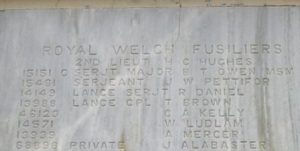
Charles Henry Roberts, Private, 204032, Royal Welsh Fusiliers. Charles was born in 1895, the son of Robert Roberts and Sarah Jane Roberts, of Ty Ucha, Penrhiw, Dolwyddelan. He worked as a furnaceman prior to the war and resided at Dolgarrog. Charles enlisted into the 4th Battalion, Royal Welsh Fusiliers at Llanrwst on 26 February 1916 and was initially placed on the Army Reserve. He was mobilised at Wrexham on 17 March 1917 and was posted to Park Hall Camp at Oswestry for training. Charles embarked at Devonport on 11 July 1917 and sailed via Taranto for Alexandria, disembarking on the 29th. He was then posted to the 1/6th Battalion, Royal Welsh Fusiliers, joining the battalion in Palestine on 11 August. The battalion was attached to 158 Brigade, 53rd (Welsh) Division and had been in Palestine since March 1917, following much service at Gallipoli and in Egypt, where it had helped guard the Suez Canal before taking part in operations to drive the Turks out of the Sinai. The EEF then turned its attention onto driving the Turks out of Palestine, and on 26 March 1917 had launched its first offensive against the coastal city of Gaza, which guarded the road to Jerusalem. Initial gains during the day were lost when the assaulting divisions lost touch with each other, and communication broke down when a thick fog cloaked the battlefield. A second attempt to force Gaza was launched on 17 April, which also failed, and the EEF suffered a change in leadership, with Sir Edmund Allenby assuming command, before being re-organised, and a third offensive was launched against a wider front from Beersheba to Gaza on 31 October 1917. This time the Turkish defences were breached, and the road to Jerusalem now lay open and the EEF began to advance north. On 6 November 1917, 158 Brigade launched an attack on the Khuweilfeh Heights. Charles was killed in action during the assault that day. The 22-year-old is buried in Beersheba War Cemetery, Israel.
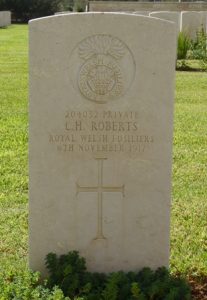
Evan Thomas, Private, 40464, Royal Welsh Fusiliers. Evan was born in 1881, the son of Thomas Peter Thomas and Catherine Thomas (nee Jones), of Cae ‘Ol, Llangelynnin. His mother died when he was young, and his father moved to 4, Mount Pleasant, Rowen, so Evan was raised with relatives before finding work as a quarryman at Penmaenmawr. He enlisted at Llanfairfechan into the Royal Welsh Fusiliers and was drafted to France in the summer of 1916, joining the 1st Battalion, Royal Welsh Fusiliers, which was attached to 22 Brigade, 7th Division. The Division had suffered heavy casualties during the opening days of the Somme offensive, which had opened on 1 July 1916, and Evan would have been among a large number of drafts for the 1st RWF. The battalion then took part in further attacks to push forwards, to the south of Mametz Wood, and upon being relieved, witnessed the troops of the 38th (Welsh) Division moving forward to launch its assault on Mametz Wood. On 14 July, with the wood taken, the 7th Division moved back into the line, with orders to capture Bazentin-le-Petit, before taking part in the terrible attacks on High Wood over the coming days. On 22 July the 1st RWF was relieved, moving back into reserve to rest and rebuild at La Chaussee. By 12 August the battalion had moved forwards to Dernancourt, and on 26 August marched further forward, to take part in the Divisions assault on Ginchy. The Division saw heavy fighting over the coming days, before the 1st RWF had another short break, but on 1 September the battalion received orders to push forwards again to launch a fresh assault on Ginchy from Montauban Alley. On 3 September 1916 the 1st RWF launched its assault, but suffered severe casualties, with over 200 officers and men killed, wounded or missing. The Division then took part in the Battle of Delville Wood, and the Battle of Guillemont, before spending the winter on the Ancre. In March 1917 the division followed up the German Retreat to the Hindenburg Line, after discovering that the village of Bucquoy had been evacuated, and began slowly following up the withdrawal, passing through St. Leger and Croisilles. Evan was wounded while the battalion was scouting around Croisilles on 29 March and was evacuated to the Casualty Clearing Station at Colincamps, where he died of his wounds on 5 April 1917. The 25-year-old was buried in Euston Road Cemetery, Colincamps, France.
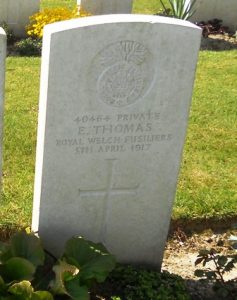
Owen Williams, Gunner, 215726, Royal Field Artillery. Owen was born in 1890, the son of William Williams and Maria Williams, of Hednant, Talybont. He worked as a labourer prior to enlisting into the Royal Field Artillery at Conwy and wafter completing his training was drafted to France to join the 92nd Battery, 17th Brigade, Royal Field Artillery, which was attached to the 29th Division. Owen would have seen his first major action on the Somme, where the 29th Division had suffered terrible losses during the opening offensive of 1 July 1916. The Division was then pulled out of the line to rest and rebuild before moving back into the line and taking part in the latter stages of the Somme offensive. The Division wintered on the Somme, taking part in the advance which followed the German withdrawal to the Hindenburg Line. At the beginning of April, the entire 29th Division moved out of the Somme sector to the Arras sector, and by 9 April took over a section of the line facing Monchy-le-Preux. The Division then began to prepare for the forthcoming Battle of Arras and at dawn on 23 April 1917, the Division launched an assault on Monchy-le-Preux. After several weeks of heavy fighting at Arras, the division was moved further north to Ypres, initially to hold the line whilst other units had been withdrawn for specialist training, in readiness for the Third Battle of Ypres, which opened on 31 July 1917. The 29th Division went into reserve whilst the first attacks, the Battle of Pilckem Ridge, took place, then on 16 August launched an attack on Langemarck. The division took its objectives, but had suffered heavy casualties, so had another period out of the line to rest and refit before taking part in further fighting near Poelcapelle. Owen was killed whilst his gun battery was supporting the fighting around Langemarck on 22 August 1917. The 27-year-old is buried in Artillery Wood Cemetery, Belgium.
William Williams, Private, 265359, Royal Welsh Fusiliers. William was born at Llangwstenin in 1886, the son of Robert Williams and Elizabeth Williams. By 1911 the family had moved to Rala, Dolgarrog and William was working as a farm labourer. William moved from home soon afterwards and lived at 5, Croft Cottages, Dolgarrog. He enlisted at Conwy into the 6th Battalion, Royal Welsh Fusiliers on 10 August 1914. The battalion was a Territorial Army unit, which mobilised at Carnarvon on 4 August 1914 attached to North Wales Brigade, Welsh Division and moved to Conway until the end of the month, before moving to Northampton. In December the Division moved to Cambridge and then in May 1915 to Bedford, where the Division was numbered and the formation became 158 Brigade, 53rd (Welsh) Division. On 19 July 1915 the entire Division sailed from Devonport for Imbros and on 9 August 1915 landed at Suvla Bay. The infantry moved off the beaches across the Salt Lake, under shellfire, into the scrub covered Chocolate Hill, but due to a lack of maps and no knowledge of the terrain, many of the units became disorientated, and the situation became chaotic. After the fighting died down, the winter rolled in, and the men first had to endure torrential downpours, which flooded the trenches, before the snow hit, and many men began falling ill in the terrible conditions. The Division was eventually evacuated from Gallipoli in December 1915, moving to Egypt to join the EEF, and helped guard the Suez Canal before taking part in operations to drive the Turks out of the Sinai. The EEF then turned its attention onto driving the Turks out of Palestine, and on 26 March 1917 launched its first offensive against the coastal city of Gaza, which guarded the road to Jerusalem. Initial gains during the day were lost when the assaulting divisions lost touch with each other, and communication broke down when a thick fog cloaked the battlefield. William was killed in action at some time during the day. The 30-year-old has no known grave and is commemorated on the Jerusalem Memorial, Israel.
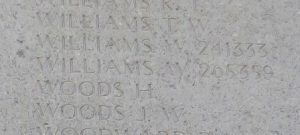
World War Two, 1939-1945
Hugh Caradoc Davies, Fusilier, 14731130, Royal Welch Fusiliers. Hugh was born on 12 August 1914, the son of Hugh Davies and Ellen Elizabeth Davies (nee Williams), of Stabla, Deganwy. The family later resided at Penyberllan, Tywyn Hill. Hugh married Vera Dorothy Jones, of Dolgarrog, in the spring of 1937 and the couple set up home at 33b, Tayler Avenue, Dolgarrog. He worked as an aluminium rollerman prior to enlisting into the 4th Battalion, Royal Welch Fusiliers soon after the outbreak of war. The battalion was mobilised at the outbreak of war, as part of 158 Brigade, 53rd (Welsh) Division and moved to Northern Ireland to begin garrison duties. The Division then moved to Pembroke Dock, before moving again to the south of England, where it trained in readiness for the D-Day Landings. On 24 June 1944 the 7th RWF left England for Normandy, and landed at La Riviere near Ver Sur Mer. The Division then took part in heavy fighting over the coming weeks, as part of the effort to break-out of the Normandy beachhead, seeing heavy fighting at Évrecy, before starting the epic advance through Northern France into Belgium and Holland. On 15 September the Division forced the crossing of the Junction Canal North of Lommel, and continued to push westwards towards Elst, between Nijmegen and Arnhem, during Operation Market Garden. On 22 October the Division launched its famous assault on ‘s-Hertogenbosch, before continuing its advance to the German frontier. Between December 1944 and January 1945, the Division took part in the Battle of the Bulge, helping in the counter-attack which helped save the Americans, who were under heavy pressure, then after the German offensive was broken, took part in heavy fighting to enter the Rhineland, taking part in Operation Plunder, the Rhine Crossings, in March 1945. Hugh was killed in Germany on 25 April 1945 during an advance intended to reach and cut off the Bremen to Hamburg Autobahn. The 30-year-old was originally buried in Vinter Moor, but in August 1946 his grave was exhumed and re-interred in Becklingen War Cemetery, Germany.

Robert William Davies, Private, 14640103, Royal Warwickshire Regiment. Robert was born in 1925, the son of Cromwell Davies and Dora Davies (nee Williams), of Bod Gwynedd, Talybont. He enlisted into the army and was posted to the 1/7th Battalion, Royal Warwickshire Regiment. The battalion was a Territorial Army unit which had been in France with the BEF in 1940, attached to the 143rd Infantry Brigade, 48th (South Midland) Infantry Division. The division saw heavy fighting along the Ypres–Comines Canal whilst holding the sector south of Houthem, Belgium between 26 May 1940 and 28 May 1940, helping allow the rest of the BEF to retreat towards Dunkirk. After its evacuation from Dunkirk, the battalion rebuilt before transferring to the 197th Infantry Brigade, 59th (Staffordshire) Infantry Division, which was in Northern Ireland. The battalion landed at Gold Beach in Normandy with the division at the end of June 1944 and joined the fight to break out from the Normandy beachhead. The division saw its first major action during Operation Charnwood, an attempt to secure the city of Caen. The city was bombed mercilessly on the night of 7 July and on the following morning the 59th Division, supported by the 27th Armoured Brigade, with the British 3rd Division on the left and the 3rd Canadian Division on the right, launched their attack. The division suffered heavy casualties over the coming days, fighting against fanatical SS and Hitlerjugend units, before being relieved on 10 July, after clearing up the final German pockets of resistance in the city. The division then received its orders to take part in the next attack, Operation Goodwood, so on 14 July moved forward ready to attack. The attack began during the morning of 16 July but met heavy resistance from the stubborn German defenders. Robert was killed on 17 July 1944, during fighting for the Ferme de Guiberon. The 19-year-old is buried in Fontenay-Le-Pesnel War Cemetery, Tessel, France.
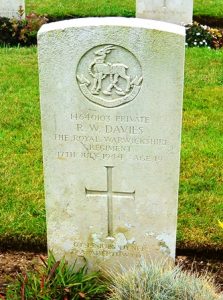
Jack Evans, Aircraftman 2nd Class, 1835451, Royal Air Force Volunteer Reserve. Jack was born in 1924, the son of William Evans and Mary Elizabeth Evans (nee Stallard). His father died soon after his birth and his mother later married William Evans and the family resided at 12, Hillside, Dolgarrog. Jack enlisted into the Royal Air Force Volunteer Reserve and trained as an Aircraftman, being allotted the rank of Aircraftman 2nd Class. He was then posted as Groundcrew to RAF Tempsford, in Bedfordshire. On 4 September 1944, Jack was cycling along the road north of the village of Sandy, together with a young lady, Miss Pitts, when a lorry struck him and killed him instantly. The lorry drove off, and a public appeal was launched just days later in an attempt to find the driver. The remains of the 20-year-old were brought home and he was buried in Talybont Calvinistic Methodist Chapelyard, Caerhun.
William Robert Hughes, Gunner, 4191063, Royal Artillery. William was born in 1918, the son of Robert Hughes and Laura Hughes (nee Williams), of 27, Tayler Avenue, Dolgarrog. He married Margaret Kate Jones of Cwm Penmachno in 1939. William enlisted into the Royal Artillery soon after the outbreak of war and was posted to the 360th Battery, 110th Light Anti-Aircraft Regiment, Royal Artillery. The regiment had been formed from the personnel of the 7th Battalion, The Dorsetshire Regiment in January 1942, joining the 43rd (Wessex) Infantry Division. The Division was stationed in Kent, where it was training hard, in preparation for deployment overseas, but remained in Britain as part of the force being built up in readiness to liberate occupied Europe. The division landed on the Normandy beaches several days after D-Day, 6 June 1944, and concentrated north of Bayeux. The division then saw its first action in the Battle of the Odon, during Operation Epsom, which opened on 26 June, with the objective of following the advance by the 15th (Scottish) Division’s advance and then to secure the captured objectives in ‘Scottish Corridor’. The divisions were subject to a counterattack by the Germans on the following day, and heavy fighting raged over the coming days. William was killed on 2 July 1944, whilst his battery was firing on German armoured units. The 25-year-old was originally buried on the battlefield near Tourville, but in February 1946 his grave was exhumed, and he was re-interred in St. Manvieu War Cemetery, Cheux, France.
Frederick Arthur William Jones, Private, 1094390, The Queen’s Royal Regiment (West Surrey). Frederick was born on 6 June 1919, the son of John Jones and Elizabeth Jane Jones (nee Paull), of 36, Tayler Avenue, Dolgarrog. He worked at Dolgarrog Aluminium Works prior to enlisting into the army and was posted to the 2/5th Battalion, The Queen’s Royal Regiment (West Surrey). The battalion had been raised as part of the 35th Infantry Brigade, 12th (Eastern) Infantry Division and had taken part in the retreat to Dunkirk in May 1940. Due to heavy casualties the division was disbanded shortly after returning to England and the 35th Brigade was later redesignated the 169th Infantry Brigade, joining the 56th Division, which was in Libya, to take part in the Italian Campaign. The division left Libya on 4 September 1943 and landed at Salerno on 9 September, seeing heavy fighting during the coming weeks. Together with the rest of the division, the brigade then began the advance northwards through Italy. The division saw heavy fighting during the coming months, as the Germans had prepared a series of very strong defensive positions across Italy, and crossed the Garigliano river in January 1944, part of the First Battle of Monte Cassino. In mid-February the division was withdrawn and was sent to Anzio, where it helped defend against a German counterattack. The division was relieved in the line at the end of March 1944 and was sent to Egypt to rebuild. The division landed back in Italy on 17 July, coming under command of the Eighth Army, and joined the fight for the Gothic Line. The 169th Brigade then captured Gemmano Ridge, where it beat off a determined German counterattack. Frederick was killed in Italy on 9 December 1944, during the height of a terrible winter. The 25-year-old was originally buried on the battlefield, but in January 1945 his grave was exhumed, and he was re-interred in Forli War Cemetery, Italy.
Ivor Jones, Private, 1832878, Pioneer Corps. Ivor was born early in 1916, the son of Evan Jones and Kate Jones (nee Roberts), of Tynymynyd, Penmachno. He married Ann Megan Davies, of Dolgarrog, in the summer of 1941. Ivor enlisted into the army and was posted to the Pioneer Corps. Very little else is known of his service, but he died on 18 March 1943, aged 27. Ivor was buried in Arwelfa Cemetery, Penmachno. Ivor is not commemorated on the Dolgarrog war memorial.
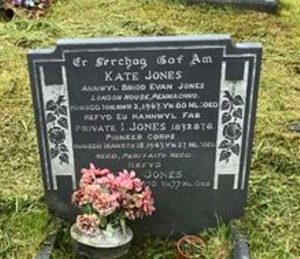
Rees Harold Jones, Flying Officer, 171937, Royal Air Force Volunteer Reserve. Rees was born in 1922, the son of William Gethin Jones and Catherine Agnes Jones (nee Evans), of Wentworth, Dolgarreg. He enlisted into the Royal Air Force Volunteer Reserve and after being commissioned as a Flying Officer in January 1944 was posted to No 7, Flying Instructor’s School at RAF Upavon, in Wiltshire. Rees began struggling with his health during his time at Upavon, and died of tuberculosis at the RAF Hospital, at Wroughton on 23 June 1945. The body of the 23-year-old was conveyed home and he was buried in St. Mary’s Churchyard, Caerhun.
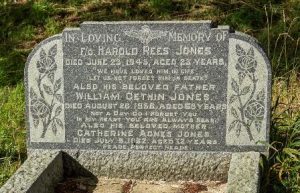
Gordon Frazer MacDonald, Private, 3607535, Argyll and Sutherland Highlanders. Gordon was born in 1922, the son of Ewen Alexander MacDonald and Annie Blodwen MacDonald (nee Jones), of The Woodlands, Dolgarrog. He enlisted into the army at the outbreak of war and was posted to the 8th Battalion, Argyll and Sutherland Highlanders. Gordon married Adelaide Mary Adams of Llanrwst in the autumn of 1941. The battalion was a Territorial Army unit, which had originally served with the 51st (Highland) Division during the withdrawal to Dunkirk in 1940. The division was annihilated and the survivors forced to surrender after becoming isolated at Le Havre. The 8th Battalion then became attached to the 36th Brigade, 78th Battleaxe Division, which had been formed in Scotland to take part in Operation Torch, the landings at Morocco, on 8 November 1942. The division then took part in the Tunisian Campaign, and following the surrender of the Afrika Korps joined the battle for Sicily, and then the campaign in mainland Italy. The division was transferred back to Egypt in July 1944 for a rest and elements of the division started the infamous Cairo riots. By October the division was back in Italy, joining the fighting for the Gothic Line. Gordon was killed in the Apennine Mountains on 11 November 1944. The 22-year-old was buried in Bologna War Cemetery, Italy. His grandfather, Morris Roberts, had died whilst serving in the army in 1918.
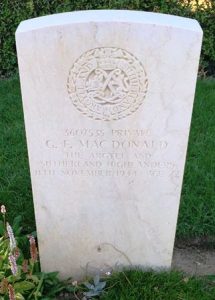
John Noel Mahler, DFC, Squadron Leader, 37452, Royal Air Force. John was born at Ludlow on 15 December 1913, the son of Henry Mahler and Mary Margaret Mahler (nee Brewer). His parents were both renowned artists and after the family moved to Frwd, Llanbedr, near Conwy, his father became an associate member of the Royal Cambrian Academy in 1919 and a full member in 1939. John was educated at Woodlands School in Deganwy and then at Loretto College, Musselburgh before gaining a position with Lever Brothers in Port Sunlight. He left his position to enlist into the Royal Air Force some years prior to the war and trained as a pilot. Following the outbreak of war he was posted to 15 Squadron, Royal Air Force and in August 1940 gained the award of the Distinguished Flying Cross. He then became a flying instructor before volunteering to go back on active service and was posted to 7 Squadron, Royal Air Force as a Squadron Leader. The squadron was equipped with the Short Stirling heavy bomber and was based at RAF Oakington, in Cambridgeshire. On 17 January 1942, John was flying a Short Stirling I, Serial W7467 over Cambridgeshire when a passing Hurricane, Serial V6865, of 56 Operational Training Unit carried out an unauthorised mock attack on the Stirling and collided with it. Both aircraft crashed to earth, killing all of their crews. John was 28 years old when he was killed that day. His remains were recovered from the wreckage and he was cremated at Cambridge Crematorium, England. A relative, Flying Officer Gilbert Francis Moncrieff Wright, was killed whilst covering the withdrawal of the BEF towards the Channel coast in May 1940, when his Hurricane was shot down; whilst his brother, Lieutenant Arthur Henry Mahler, served during the war with the Intelligence Corps and died on 8 September 1947.
Peter Davies Randall, Sergeant, 567345, Royal Air Force Volunteer Reserve. Peter was born in 1918, the son of John Randall and Martha Randall (nee Davies), of 8, Croft Cottages, Dolgarrog. He enlisted into the Royal Air Force Volunteer Reserve and after completing his training as a Flight Engineer was posted to 76 Squadron, Royal Air Force, which was an RAF Bomber Command unit based at RAF Middleton St George, in Durham. On 30 December 1941 Peter took off from Middleton St George aboard a Handley Page Halifax II, Serial L9615, which was part of a force of bombers despatched to attack German warships in Brest Harbour. The Halifax was shot down by flak and crashed off the French coast that day, killing all seven of her crew. Peter was 24 years old when he was killed that day and is commemorated on the Runnymede Memorial, Surrey.
Edgar Roberts, Warrant Officer II, 4190323, Essex Regiment. Edgar was born in 1910. He married Sarah Davies, of Dolgarrog, in 1935, and the couple set up home at 2, Graham Road, Dolgarrog. Edgar originally enlisted into the Royal Welch Fusiliers, but was later posted to the 2nd Battalion, Essex Regiment. The battalion had originally served in France with the BEF in 1940 attached to the 25th Infantry Brigade, 50th (Northumbrian) Infantry Division. After evacuation from Dunkirk the battalion remained on home defence duties with the 25th Brigade until February 1944 when it became part of the 56th Independent Infantry Brigade, alongside the 2nd Battalion, South Wales Borderers and 2nd Battalion, Gloucestershire Regiment and began training in earnest for the invasion of Europe. The battalion landed at Gold Beach on D-Day, 6 June 1944 with the rest of the brigade and began driving inland and liberated Bayeux the following day. The brigade then liberated Tilly-sur-Seulles, before seeing further heavy fighting north of St Germain d’Ectot and took part in the liberation of Thury-Harcourt. Edgar was killed in Normandy on 9 July 1944. The 34-year-old was originally buried on the battlefield near Granville, together with several comrades, but in June 1945 their graves were exhumed, and the men were re-interred in Hottot-Les-Bagues War Cemetery, France.
J Smith, Sergeant, Royal Air Force. The memorial names J. Smith and that he served as an Observer. He cannot presently be identified.